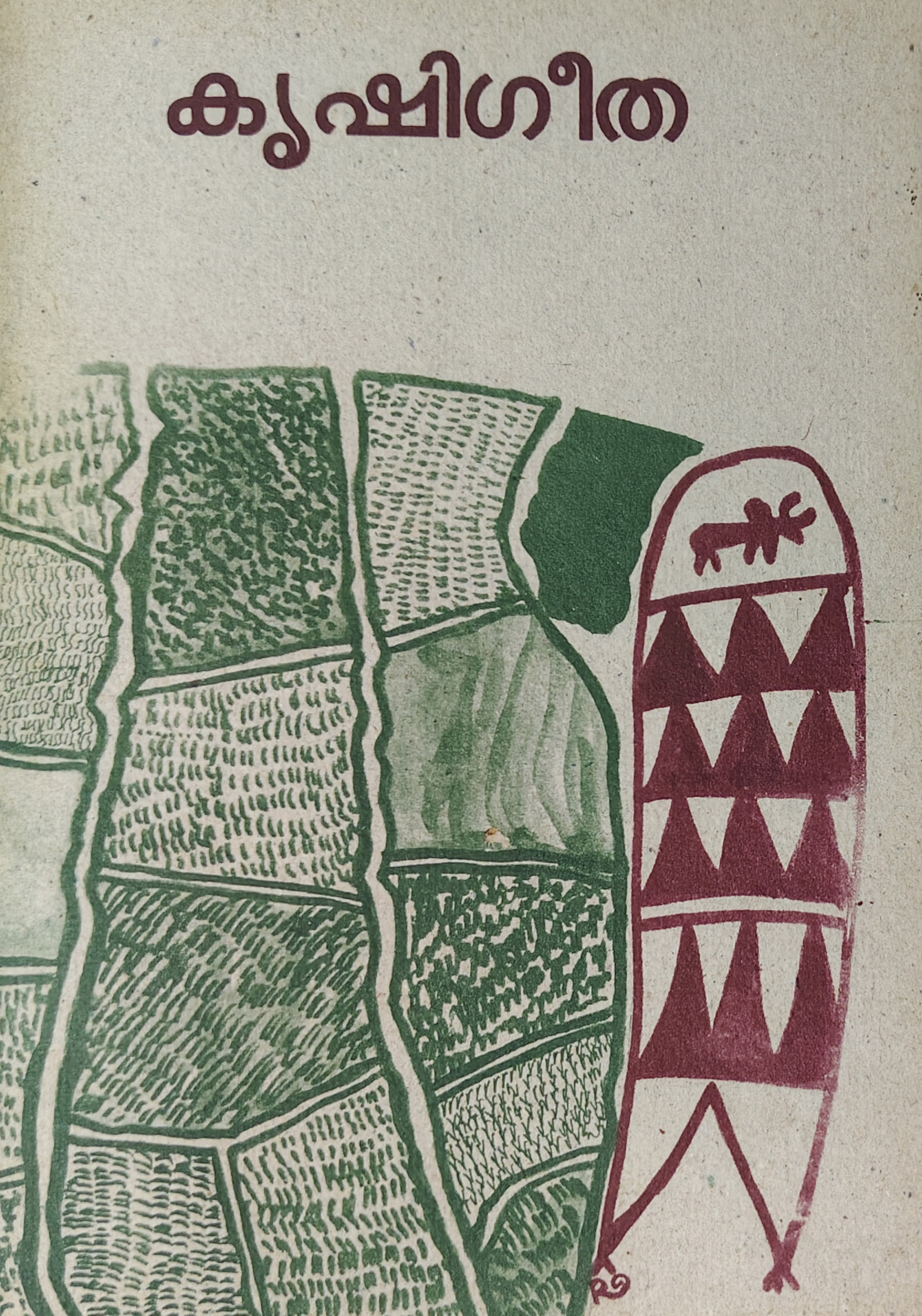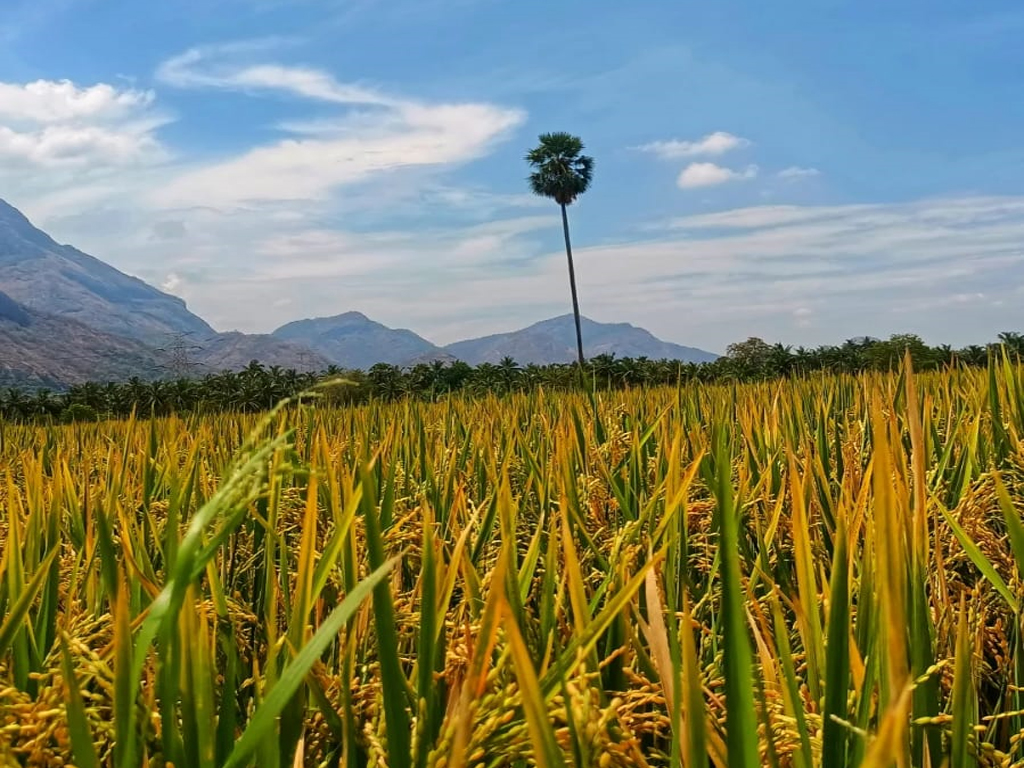Krishi Gita: The Timeless Repository of Agricultural Wisdom
Dr.M.K.Premarajan
Deeply intertwined with the soil and spirit of Kerala lies its rich agricultural heritage. The southwest and northeast monsoons have historically nurtured the flourishing agriculture of this land. Once, paddy cultivation formed the backbone of Kerala's economy and culture. Within this vibrant tradition shines a remarkable chapter: 'Krishi Gita,' also known as 'Krishippattu' – a treatise of agricultural knowledge. Krishi Gita stands as a primary ancient source of Kerala's agricultural wisdom.

Kerala's agricultural heritage extends beyond mere farming practices; it embodies the intergenerational transmission of knowledge rooted in an understanding of nature's essence. Agriculture holds a profound connection with the cultural celebrations of the people of Kerala. Rituals associated with harvest, such as 'Niraputhari' and 'Illam Nira,' along with Kerala's national festivals of Onam and Vishu, are inextricably linked to agriculture. This clearly illustrates the significance of agriculture in the socio-cultural fabric of Malayalis. Krishi Gita, a comprehensive text addressing all aspects of agriculture, naturally becomes not just a conduit of agricultural knowledge but also an expression of a way of life. Beyond being historical records, it encompasses practical lessons that can aid in addressing modern agricultural challenges.
Krishi Gita: Origin and Historical Backdrop
Krishi Gita was first published by the 'Bulletin of the Government Oriental Manuscripts Library of Madras,' edited by Vidwan C. Govinda Variyar. It can be inferred that Krishi Gita is the contribution of an individual with extensive experience gained through continuous engagement in agricultural practices. From the medieval period onwards, Krishi Gita enjoyed widespread popularity among the people of Kerala. This agricultural song circulated orally throughout the land. The edition published by the Thrissur Folklore Study Center mentions that a palm-leaf manuscript of Krishi Gita is part of the handwritten collection of Punasseri Nambi Neelakanda Sharma. That copy also notes that a new coin was given to Raman on Sunday, Kumbham 8, Kollam 1023 (1848 AD). The same edition suggests that it might have been written down based on what Raman narrated. However, it is unlikely that Krishi Gita was solely an orally transmitted song. Commencing literary works/poems with a salutation to deities was a prevalent custom in the medieval period of Malayalam literature. Each chapter of Krishi Gita begins with a eulogy to Parasurama. Krishi Gita is composed with the underlying concept that Parasurama is explaining agricultural matters to the Brahmins of Kerala. Similar to the Sanskrit text 'Keralakalpam,' Krishi Gita follows a narrative style that outlines suitable lands for cultivation, unsuitable lands, the qualifications farmers should possess, and the criteria for selecting seeds. In this regard, it can be inferred that Krishi Gita was inspired by the 'Keralakalpam' text.
Krishi Gita: A Concise Encyclopedia for Agricultural Practitioners
Krishi Gita can be described as a concise encyclopedia for those engaged in agricultural practices. It includes the story of Parasurama and the legend of the Chera and Chola kings propitiating Indra for rain. The exact period of Krishi Gita has not been precisely determined. However, K.P. Padmanabha Menon, in his 'Kochi Rajya Charitram' (History of the Cochin Kingdom), observes that the mention of Chinese chili ('Cheenamulaku') and Turkish chili ('Parankimulaku') in Krishi Gita suggests that its period is after the arrival of the Portuguese in Kerala. Nevertheless, some editions only use the term 'mulaku' (chili). Therefore, the qualifiers 'Cheenamulaku' and 'Parankimulaku' might have been added later during transcription.
Key Agricultural Principles in Krishi Gita
Krishi Gita goes beyond simply stating farming methods. It delineates who are qualified and unqualified to cultivate, the mandatory etiquette a farmer must adhere to, descriptions of essential tools and equipment, the necessity of having sufficient funds to pay laborers, and knowledge regarding seed selection, soil management, organic fertilizer application, pest control, animal husbandry (including how to build a cattle shed and organize a manure pit), and weather observation. Furthermore, Krishi Gita is a comprehensive agricultural encyclopedia that also incorporates astrology and legends.
Seed Selection: Wisdom from Krishi Gita
Krishi Gita urges the adoption of indigenous seeds suited to the soil, rejecting foreign varieties. Interestingly, it expresses a sense of loss for the ancient seeds that have disappeared and asserts the superiority of native seeds, echoing our present-day belief that the 'Anthakan' seed is unsuitable for our agricultural culture.
Consider this:
പണ്ട്പണ്ടുള്ള വിത്തുകളെല്ലാമേ
കണ്ടാലുമറിയാതെ മറഞ്ഞുപോയ്
നിഷ്ഠുരങ്ങളാമിന്നുള്ള വിത്തുകൾ
കുഷ്ഠരോഗാദി വർദ്ദിപ്പിക്കും ദൃഢം
The text discusses seed germination, preparing the land for planting, and sowing/transplanting. Traditional seed treatment methods like exposing seeds to dew (Maampookaanikkal/Manjukkollikkal) are found in Krishi Gita. These practices align with scientific principles that enhance seed germination.
Soil Management Insights
Krishi Gita elaborates on suitable soil types and weeds. It recommends having a cover crop of legumes in the field, which should be cut and used as mulch during the summer to conserve soil moisture. The practice of adding tender banana stems mixed with cow dung during the final plowing is also mentioned. These recommendations are conducive to maintaining soil health and promoting biodiversity.
Organic Farming Principles
Krishi Gita advocates for animal husbandry to be in accordance with organic principles. It states that plant protection aids like neem should be found within the farm or on its borders, and that adding leaves of Strychnos nux-vomica (Kanjiram), Pterocarpus marsupium (Venga), bamboo (Panal), mango (Maavu), and bamboo (Mula) to green manure will প্রতিরোধ pests and diseases. These guidelines resonate with the principles of modern organic farming.
A Spectrum of Paddy Varieties in Krishi Gita
Krishi Gita details numerous indigenous paddy varieties.

കേരളം പരദേശമെന്നിങ്ങനെ
പാരം ഭേദമില്ലെല്ലാറ്റിനും നിർണ്ണയം
ആസുരങ്ങളാം വിത്തുകളേറെയും
ഭൂസുരരേ പരദേശത്തിലുള്ളവ
മലയാളത്തിൽ തന്നെ വിളയുന്ന
മലവിത്തുകളുണ്ടു പലവിധം
Following this, the author discusses "the seeds that grow in the cultivated lands of Tulunadu." Krishi Gita mentions a rich array of paddy varieties including Kamadara, Mukkinnaveluthe, Jeerakashala, Cheruvithu, Dandan, Vettiveliyeri, Churulakkarivi, Vazhakannan, Vellachennellu, Sampathalan, Karinjenellu, Kunjivithu, Kozhivalan, Ponnariyan, Kazhama, Mundakan, Payyanadan, Vali, Puthan, Modan, Cherumodan, Nirakan, Paramban Kazhama, Malayudumban, Kodanellu, Karippali, Aariyan, Kaali, Mundappalli, Navara, Kozhivala, Pooncha, Cheppilakkadan, Chentharmanniyan, Vellakkurinji, Kuttadan, Cheppilakkadan, and Kuvvalakkadan. It doesn't merely list names but also specifies which seeds are suitable for different soil types and seasons. For instance, Pokkali is recommended for saline areas, Modan for drought-prone times, and Koottumundakan for waterlogged conditions. This guidance assists farmers in selecting paddy varieties appropriate for their local environments. The mention of medicinal rice varieties like Rakthashali and Navara aligns with the holistic health perspective presented by Krishi Gita. Beyond paddy, this esteemed text shares knowledge about various other grains like Thinna (foxtail millet), Cholam (sorghum), Payar (beans/pulses), Kambam (pearl millet), Cholam (maize), and Kadalaykka (groundnut), as well as vegetables and crops ranging from Amaraykka (hyacinth bean) and different types of chilies to Vazhuthina (eggplant), Chena (yam), Karimp (sugarcane), tobacco, betel leaf, and areca nut. The author's skill in presenting all this information beautifully in verse form is commendable.
Cattle Shed Construction and Animal Husbandry
The second part details cattle shed construction, animal care, agricultural implements, the qualifications for becoming a farmer, and land preparation methods.
കൃഷി ചെയ്തു കഴിയാത്തവർക്കൊരു
വഴിയില്ല പിഴപ്പിനു ഭൂതലേ
ദാരിദ്ര്യങ്ങൾ കളയേണമെങ്കിലോ
നേരത്തേ കൃഷിചെയ്യേണമേവരുംThe second part begins by emphasizing the importance of agriculture. It then elaborates on the aspects to consider while constructing a cattle shed. It specifies the need for hay racks and water troughs, constructing a manure pit adjacent to the shed, and housing bulls, bullocks, and calves in separate areas. The text stresses the importance of a sturdy shed and constant attention to the livestock, even at night, along with the daily bathing of calves.
Agricultural Implements and Farmers' Qualifications
Further, it describes the necessary agricultural implements and advises selecting skilled laborers and paying their wages ('valli') promptly. While cautioning against cultivating by encroaching on pathways, it warns:
അതിർനീക്കി
വിളയിപ്പവർക്കൊരു
ഗതിയില്ലാ പരലോകത്തിങ്കലും
The author clearly outlines the social awareness and sense of justice that farmers should possess. It doesn't end there; the etiquette and character traits of a farmer are also described. He should be a believer in God, not lazy, unintelligent, a thief, or an alcoholic. After detailing the qualifications of a farmer, the text describes the preparation of land for cultivation.
വേലികെട്ടീട്ടു വേണം കൃഷീവലർ
കാലവേ വിതപ്പാനും നടുവാനും
പ്ടത്ത് വളമിടണം, വരമ്പുകളിൽ പുല്ലുങ്ടായിരിക്കരുത്
The author provides expert advice on even the most trivial matters, such as fencing before sowing and planting, fertilizing the field, and ensuring that bunds are free of weeds. It elaborates on the care to be taken while planting paddy and vegetables, distinguishing between different varieties.
Legends and Seasonal Agriculture
The second part also narrates the story of the Chera, Chola, and Pandya kings who performed penance for rain, the imbalanced distribution of rainfall received by the three groups after obtaining the boon, and their subsequent appeal to Devendra and resolution through mutual cooperation. The third part details the suitable crops for different 'Njattuvela' (nakshatra-based agricultural seasons).
It advises careful cultivation during the Bharani Njattuvela, recommending the sowing of Cherumodan variety during this period and stating that Karippali seed is not suitable for Virippu (autumn harvest) cultivation in Bharani Njattuvela. Rohini Njattuvela is considered best for sowing Kazhama seeds, while Thiruvathira Njattuvela is ideal for Virippu cultivation. Those who cultivate Virippu during Punartham Njattuvela are deemed unwise. It specifies that chilies should be planted during Thiruvathira Njattuvela, thus providing authoritative information on agriculture during the Njattuvela seasons. The fourth part also extensively discusses the agricultural tasks to be performed and the seeds to be sown in each season. It includes details about the months when rainfall intensifies. Furthermore, the fourth part describes the characteristics of cattle, the care to be taken in their management, common diseases they encounter, and their remedies.
A Comprehensive Guide to Ancient Agriculture
Across these four parts of Krishi Gita, the author comprehensively, simply, and meticulously details all aspects related to agricultural practices.
Contemporary Relevance of Ancient Agricultural Wisdom
The constant changes in climate pose significant challenges for farmers today. Ancient knowledge like that found in Krishi Gita can provide valuable insights to overcome such situations that challenge modern agriculture. Integrating this traditional knowledge with modern science to formulate new agricultural policies could greatly benefit Kerala's agricultural sector.
Revitalizing Kerala's Agricultural Sector
Kerala's agricultural sector has gained renewed vitality through numerous governmental interventions. In the rural parts of Kerala, voluntary organizations, residents' associations, and individuals, recognizing the importance of organic farming, are making healthy progress in this field. Let me conclude by pointing out some steps that could help energize such efforts:
- Conduct more research and studies on ancient agricultural texts like Krishi Gita.
- Formulate more government-level schemes to conserve the genetic pool of traditional paddy varieties and promote their cultivation.
- Create awareness among farmers and the general public about the Nakshatra-based agricultural calendar (Njattuvela) and its scientific basis.
- Integrate traditional farming methods with modern technologies to develop sustainable agricultural models.
References
- കൃഷിഗീത, ചൊല്ലുും വായനയും, 1999, നാട്ടറിവ് പഠനകേന്ദ്രം തൃശൂർ
- കെ.പി പദ്മനാഭമേനോൻ, കൊച്ചി രാജ്യചരിത്രം, മാതൃഭൂമി 1989
- വിഷ്ണു നമ്പൂതിരി. എം.വി, ഫോക് ലോർ നിഘണ്ടു, കേരള ഭാഷാ ഇൻസ്റ്റിറ്റിറ്റ്യട്ട്, 2000
- https://www.newindianexpress.com/cities/kochi/2014/Jun/28/flourishing-period-for-crops-629637.html
- https://agronature.org/kerala-njattuvela/
- https://www.manoramaonline.com/karshakasree/features/2020/09/25/desi-paddy-seed-conservation-of-a-farmer.html
- https://malayalam.indianexpress.com/health/njavara-rice-variety-is-one-of-the-best-grains-in-ayurveda-why-883699/
- https://truecopythink.media/history/m-sreenathans-chanakya-series-part18
As an Amazon Associate, we earn from qualifying purchases made through links on this site.

